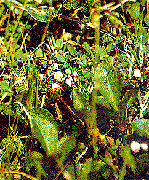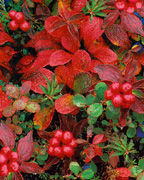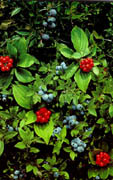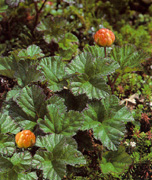 |
Summer Flowers, Fall Fruit |
 |
Summer Flowers, Fall Fruit |
Churchill Main Page/ Introduction to Churchill's Polar Bears/ Practicalities/ Churchill the Town
botany/ Whales/ Birdwatching/ Geology/ Ecology/ Fun
Autumn's Bounty of Beautiful Fruit
|

|
Say the word "tundra," and people envision a vast wasteland of empty space where nothing grows but lichen and reindeer moss, a bleak wasteland. Nothing could be farther from the truth. Here, spring moves quickly into vigorous summer. During late June through early August, nothing is dead or colorless. Charlotte Seline Bompas (1830-1917), wife of the first Bishop of Selkirk (Yukon), kept a journal that described spring and summer in the far north. Churchill is very much like this: |
|
. "The rapidity with which the summer comes on here is quite wonderful. The ice only began to give way on May 13, and at that time, of course, the snow lay thick everywhere and by the end of the month the small gooseberry bushes were in blossom ... every bush round seems to bear promise of berries, and we walk on a carpet of wild strawberry blossoms. At a quarter to ten in the evening, the sun sinks down almost in the same place where it rises then follows out a long beautiful twilight. There is really no night even now. And at two in the morning, the dawn begins and birds chirp-one very like a thrush." |

|

|
. Boreal botany is special. The ground is soft. Lignonberries and crowberries, dewberries and cloudberries grow right through a natural mulch of living sphagnum moss and tangle themselves among and around other species, such as minute orchids that grow spikes no taller than three inches. These spikes sprout flowers no larger than a baby's smallest fingernail that open into forms as complex and colorful as any you find in a florest's shop. One type is even mosquito-pollenated. Arctic Dryas flower on the beaches. A miniature rose relative, the white-petaled, yellow-centered Arctic dryas, can be seen on sand dunes near the beach and alongside creeping willow shrubs inland, as well as in boreal forest glades. It, along with the bright reddish-purple legume the locals call "sweet vetch," is the most commonly found plant in bloom. In very moist areas, a carnivorous species called Pinguicula vulgaris, or common butterwort, produces a flower that at casual glance looks just like a violet. It catches then digests tiny insects right on its sticky leaves. |
|
Summer days can get quite hot, even into the eighties. Boreal botany thrives. Plants such as Arctic dryas flower and set seed or fruit almost as quickly as do desert ephemerals. Insects, voraciously hungry for flesh and blood and nectar, instinctively know that they must cram their entire life cycle into the few months of sunshine between when the snow finally melts away in May or June, and autumn's first hard frost. Their presence, and their appetites, present challenges for animals and humans. Samuel Hearne A Journey from Prince of Wale's Fort in Hudson's Bay to the Northern Ocean, 1769, 1770,1771,1772 ed., Richard Glover, Macmillan and Co. Ltd., Toronto. (1958) A fine course for Churchill Canada botany or Arctic Botany in general. |

|

|
. If you have a camera with interchangable lenses, bring a macro lens! If your main focus is to photogrgraph botany, consider a macro lens essential. If you can only bring one lens, bring a macro. Plant life on the Tundra is dwarfed. Summertime flowers are often minute, some no more than 1/16th of an inch. One of the most beautiful, Orchis rotundifolia, is a terrestrial orchid with a flower spike no more than 3 inches tall. Upon this spike can be found three to five highly complex orchids, tinted in shades in purplish-pink to white, with reddish-brown spots on the part I call a "tongue." None is larger than a quarter-inch. Another species of orchid, with even smaller flowers, is mosquito-pollenated. Another beauty you'll want to capture is a Pingicularia vulgaris, a tiny carnivore that captures mosquitoes and other small insects on its sticky leaves, then digests them. At first glance, the flower looks like a violet. If you get down close and don't know any better, you might mis-identify it as a columbine due to the "horn" that curves downward from behind. To do these and other flowers justice, you'll definitely need that macro. |
Arctic botany, Churchill Canada Botany, MacKenzie's vetch, boreal botany, Arctic dryas
Return to Reasons
botany, Arctic botany, Churchill Canada Botany, MacKenzie's vetch, boreal botany, Arctic dryas